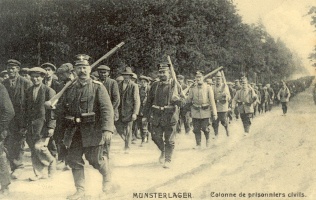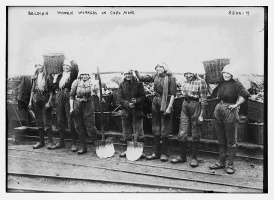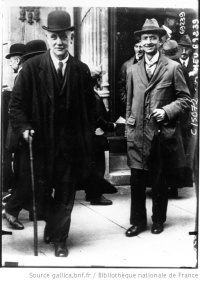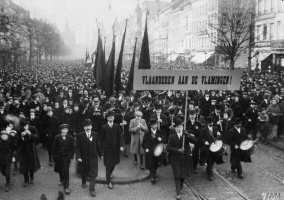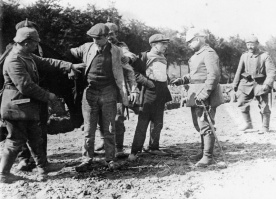Introduction↑
The First World War had a considerable impact on Belgian labour. The material situation of Belgian workers deteriorated through a decline in the standard of living and the emergence of mass unemployment. The First World War opened the door for the integration of the Belgian labour movement in the political system, with a socialist party supporting the war effort unconditionally. Protest against the war was limited and without impact on the dominant line of the party.
Belgian labour in the First World War is relatively well researched, but key publications date back to the politically oriented labour movement historiography of the 1970s, focussing more on organisations than on the workers themselves. For wages and working conditions, we can rely on the well-researched standard of living studies of Peter Scholliers. Aspects such as war protest and pacifism are also part of other historiographical traditions, as is the history of Flemish nationalism.
Wages, Working Conditions and Unemployment↑
The First World War led to a sharp decline in the standard of living of Belgian workers, due to the breakdown of economic activity, the rise of unemployment and German monetary and economic exploitation. Many Belgian workers were deported to Germany in 1916 to work in the war economy, while others had been fighting since 1914 at the Yser Front, cut off from the occupied part of the country. The unemployed were a matter of concern for the economic elite, who set up a national unemployment benefit system. Workers expressed their discontent through strikes and social protest.
Belgium was a highly industrialized country. This industry was not exploited in a systematic way by the Germans, who preferred looting over industrial production. The British blockade cut Belgium off from international trade and supplies of raw materials, leading to a sharp decline in industrial production. In 1918, the index of economic activity was only twenty-nine as compared to 100 in 1913.[1] The consequence was mass unemployment. In February 1915, about 600,000 people were (partially) unemployed, which was half of the workers counted in the 1910 industrial census.[2] In some industrial centres, up to 90 percent of the workers were jobless.[3] Those who had a job could often only work on a part-time basis. There was one general exception to this industrial standstill: the coalmines continued production, also for the Germans.[4]
The wage level did not change much during the war years: as compared to 100 in 1914, the same index was 107 in 1915, 111 in 1916, 115 in 1917 and 141 in 1918. This wage index, calculated by Peter Scholliers for Brussels, is more or less representative for the whole country, taking into account the mixed economic activity in the capital. For the miners, wages developed differently: as compared to being 100 in 1914, the index was eighty-eight in 1915, ninety-five in 1916, 123 in 1917 and 178 in 1918.[5]
Since prices, especially food prices, increased dramatically, purchasing power was undermined: in 1918, the purchasing power of Brussels workers was only 25 percent of the 1914 level.[6] The situation worsened as the war went on, with the winter of 1916-1917 as the low point: workers once again ate the bread and potato based menu of 1860 and were thrown back on food distribution in soup kitchens, which served 40 percent of the population. In the industrial provinces of Hainaut and Liège, 65 and 56 percent of the population respectively used soup kitchens, against only 5 percent in the agricultural province of Luxemburg.[7]
This points to the cleavage between the industrial centres and the countryside, where people had direct access to food and were able to make money selling food to the inhabitants of the cities or workers living in the industrial centres. This situation explains the specific form collective actions took. More than wages, price increases and food shortages triggered social protest in which miners played an important role. Striking against employers was not the only protest method; there were also food riots against farmers, traders and profiteers. The objective was often obtaining a maximum price or putting an end to the export of food from the Belgian border regions to Germany.[8]
High unemployment became a social as well as a political problem. Before the war, unemployment insurance was organized on a local basis, often by the trade unions. Local authorities in industrial centres subsidized these unemployment funds, which were not designed for mass unemployment as in World War I. The National Committee for Food and Aid, a national organization for food supply and social aid set up by the economic elite, organized a national unemployment insurance system, which supported the unemployed in need who had worked before June 1914. The unemployed had to accept any suitable work and young people had to take part in professional training courses. There was control of the unemployed and their morality, especially for women. These conditions made the unemployment insurance, which still had its opponents, acceptable. Other arguments for a national unemployment insurance were that it could prevent the jobless accepting work from the Germans and that the income of the unemployed generated purchasing power for the retail sector.[9]
Unemployment benefits limited the social impact of loss of work: in September 1917, the difference in calorie intake between a worker and an unemployed person was relatively small: while a person with a job ate 1,500 calories a day, an unemployed person ate 1,387 calories.[10] This led to tension between workers and the unemployed: in the Liège basin, miners argued that some unemployed people had better living conditions than miners, who did not have enough to eat for their heavy work. This way of thinking reflected a change in the opinion of the unemployed. At the beginning of the war, the unemployed were seen as victims and patriots, since they did not want to work for the Germans. German campaigns and the deterioration in the standard of living changed this view of the unemployed, who were associated with unwillingness to work. The occupation authorities campaigned for labour in Germany using arguments that paralleled the ideas of part of the Belgian elite. (Forced) labour was in the interest of the workers to maintain their skills, and the financial burden of the unemployment system was too high and could not be maintained in a long war. When the deportations started in October 1916, no distinction was made between the unemployed and workers who had a job. International protest put an end to the deportations, but campaigns for voluntary work in Germany continued. They had only limited success, which can be explained by the poor working and living conditions of those who had been forced to work in Germany. About 60,000 people were deported to Germany. Depending on the estimate, between 1,250 and 1,316 of them lost their lives.[11]
Part of the Belgian workforce had fled the country in 1914 with other groups of the population. In Great Britain, Belgian metalworkers were employed in the weapons industry. Delegates of the Antwerp section of the metalworkers’ union defended their material and political interests. The Belgian government saw those workers as a recruiting reserve for the army, but having a job protected one from military service. The organization set up a job placement service and unionized women in order to avoid them being used as a cheap labour reserve to free men for the army. The trade union encouraged cooperation between Belgian and British workers and eased tensions between both groups. Belgians, willing to accept less favourable working conditions (wages and working conditions were better in Great Britain than in Belgium) were seen as competitors by British workers. Another source of tension was that work in Britain protected the Belgians from being sent to the front, in contrast to their British colleagues.[12]
Protest Against the War↑
The Belgian socialist party voted for war credits and supported the war effort. As Marcel Liebman (1929-1986) argued in 1986, the vote in favour of war credits was not that surprising. Socialist parties in other countries did the same, and Belgium, attacked by Germany, could invoke legitimate defence. In the party, a pacifist wing coexisted with Belgian patriotism. The engagement for the war effort was the start of the integration of the party in the political system: party-leader Emile Vandervelde (1866-1938) became minister of state after the invasion (together with liberal politicians) and, in 1916, full minister in the Catholic government. The socialist party was, through the National Committee for Food and Aid, involved in the management of social policy in the occupied territory and followed the line of the Union sacrée, meaning that internal political divisions were put aside in order to give priority to military victory. Patriotism prevailed over social antagonisms, which became more outspoken as the war went on. The socialist party strived for a total defeat of Germany and could not accept a negotiated peace or a peace by compromise. This patriotism (even chauvinism) and jusqu’au boutisme put the Belgian socialist party at the most right wing position in the Second International, presided over by Vandervelde. Personalities such as the pre-war left wing militant Louis De Brouckère (1870-1951) volunteered for the army and travelled, later, to Russia to prevent the soldiers from supporting the revolutionaries[13].
Opposition against the war was limited to a minority within the socialist party, of which the Antwerp leader Camille Huysmans (1871-1968), also the secretary of the Second International, was the spokesman. Huysmans strived for a negotiated peace under the aegis of the Socialist International. This idea was formulated at the Zimmerwald Conference (September 1915) and elaborated in 1917 at the Stockholm Conference. Huysmans’ engagement for Stockholm and a negotiated peace was not appreciated by the socialist party, which maintained the Union sacrée policy.[14]
“Stockholm” became a rallying point for critics of the Union sacrée. Joseph Jacquemotte (1883-1936) defended “Stockholm” – without success – in the council of the party, where he also campaigned to put an end to the participation in the government in order to take up pre-war class struggle again. Jacquemotte was sympathetic to the Russian Revolution, but more morally than politically, since he maintained his confidence in the socialist party, where he developed left wing opposition.[15] After the war, he became one of the founding fathers of the communist party.
A second group of left opposition against the war was part of “activism”. The German occupiers systematically exploited the language division in Belgium with Flamenpolitik. They made concessions to the Flemish movement in order to weaken the Belgian state, for example organising courses in Dutch at the state university in Ghent. In 1917, the Belgian state was divided administratively and politically along linguistic lines, with a sham parliament for Flanders. Those in the Flemish movement who supported this policy and thus collaborated with the German enemy were called “activists”. The Flemish movement was basically a petty bourgeois movement and represented a semi-intellectual secondary elite, whose social mobility was hindered by the primacy of the French language. German socialists tried to exploit the language divide within the socialist movement as well, but success was limited, especially in Ghent, the stronghold of organised socialism in Flanders. Its leader, Edward Anseele (1856-1938), remained loyal to the Belgian state in which he had built a network of workers’ organisations.[16]
Small groups in the socialist movement, however, were receptive to Flamenpolitik. The socialist youth (Socialistische Jonge Wacht), inspired by its anti-militarist and internationalist tradition, supported Zimmerwald. They rejected the support of the party for the war effort and came, in 1917, in the slipstream of activism in Antwerp, where the socialist movement was less developed compared to Ghent and more connected with bourgeois radicalism. A central figure in this “red activism” was Jef Van Extergem (1898-1945). He combined social and Flemish struggle against the Belgian bourgeois order, campaigned against the Union sacrée, and defended internationalism. Support for the Stockholm Conference and a negotiated peace made the link with the demands of the Flemish movement. A peace by compromise would result in a neutral Belgium that could be split up on linguistic lines, giving Flanders political autonomy. Van Extergem could not count on the sympathy of the Antwerp socialist party, nor of Huysmans, who was open to the demands of the Flemish movement but rejected activism and stood for the unity of the Belgian state[17].
Socialist activists such as Van Extergem were isolated and were, as Vincent Scheltiens labelled them recently, a “tiny minority”: Van Extergem’s Antwerp group numbered about twenty members.[18] Van Extergem established a new organisation, the Vlaamsche Sociaal-democratische arbeidsgemeenschap, with sections in other cities, which numbered about 1,500 members. In 1917, the Russian Revolution became the new focal point: it would bring peace and a world Soviet, opening perspectives for a Flemish and Walloon Soviet and political autonomy for Flanders.[19]. Van Extergem would join the communist party after the war
The leftist socialists campaigning with Huysmans were less isolated and more linked to the working class (as the diamond sector) compared to the “red activists” and remained in the party[20]. In the organisations of socialist refugees in the Netherlands, France and Great Britain there was more support for the position of Huysmans and criticism of the Union sacrée. The metalworkers union in Great Britain campaigned for Huysmans’ ideas[21]. Marcel Liebman pointed, in this respect, to the dual isolation of the socialist party in Belgium, both internally and internationally, as the explanation for its outspoken rightist position. In Belgium, there was no normal party-life, since the possibility of organising meetings with the rank and file was restricted by the Germans. As a consequence, opportunities to debate and contest the dominant party line were limited. In the Netherlands, France and Great Britain, Belgian socialist organisations could profit from freedom of expression and organisation, explaining the support for Stockholm and the distancing from the Union sacrée[22].
Opposition against the war only had a limited audience with socialist labour. The most outspoken war opponents, the socialist activists, did not recruit from the blue collar workers, but rather from the lowest strata of the intelligentsia[23]. Some Walloon socialist leaders even supported right-wing Belgian nationalism[24]. A context factor to understand this limited impact was that the top part of the Belgian army and especially Albert I, King of the Belgians (1875–1934) refused to participate in the murderous offensives of the allies and basically consolidated the positions taken on the Yser Front in November 1914.[25] The division of the territory prevented direct contact between the soldiers fighting on the Yser Front and the workers in the occupied part of the country. As a consequence, there was no first hand transfer of the war experience of the soldiers to their peer group in the “homeland”.
Opposition against the war took a specific form on the Yser Front, organised by the Frontbeweging, a minority group within the Flemish movement. Mainly Catholic intellectuals and priests, they politicised the language divide in the Belgian army – French speaking officers commanded an army composed mainly of Flemish soldiers – and promoted identification with the Flemish nation. The Belgian government was not prepared to make many concessions and the Frontbeweging became radicalised and demanded political autonomy for Flanders in 1917. The Frontpartij, which grew out of this movement, propagated the “no more war idea” from 1919. The basis for mobilisation was not class, but language and Flemish identity[26].
In 1918, war weariness was growing. An indication is that, in January 1918, a motion of Jacquemotte in favour of a meeting of the Socialist International was supported by sixteen members of the general council of the party, while twenty-two were against it. The majority still held to the line of the top of the party, but Jacquemotte was no longer completely marginalised, as in August 1917, when his proposal to support the Stockholm Conference received only five votes out of seventy-five[27]. The creation of new socialist activist groups outside Antwerp started only in late 1917 and 1918. In Ghent, for instance, where identification with the Belgian state prevailed, the socialist activists only organised from December 1917.[28] At the Yser Front, war fatigue increased from the autumn of 1917. The war volunteer turned pacifist Antoon Pira (1887-1939) founded an alternative organisation for the elitist Frontbeweging in May 1918, combining language with social demands. Inspired by the Russian Revolution, he created Soviets and organized strikes in his regiment in 1918 and soldiers defected to the Germans[29].
When the defeat of Germany became likely in October 1918, German and Belgian authorities made preparations for the retreat and the transfer of power. For the Belgian authorities, avoiding a power vacuum and maintaining law and order were the priorities. In Brussels, a short-lived German central workers’ and soldiers’ council was established on 10 November. Attempts to fraternize with the Belgian population were opposed by the leadership of the socialist party, who also rejected invitations to cooperate with the council.[30]
The party gave priority to universal male suffrage, a central demand before 1914, and trade union freedom. In the context of the revolutionary climate in Europe – of which the Brussels workers’ and soldiers’ council was perceived by the elite to be a symptom[31] – the king and the Belgian economic elite were open to making political concessions to the socialist party, which had proved to be a loyal political partner during the war. This was done in a series of meetings held in Loppem immediately after the armistice. The material deprivation and breakdown of purchasing power fuelled a strike wave starting after the armistice, resulting in the eight-hour working day, trade union recognition, collective bargaining at sector level and the linking of wages to the retail price index. National unemployment insurance was continued after the war. Working class identity was enhanced by the war: Belgian workers had suffered, not only from material deprivation, but also from deportation. This suffering and martyrdom (for which the Germans, not the bourgeoisie, were blamed) was used as an argument to demand material progress. The Belgian workers were victims but had also contributed to the victory of law and justice[32] by supporting the military effort of Belgium and putting aside political divisions with the Union sacrée. This led to patriotic euphoria in the socialist party and contributes to explaining why communism, rooted in protest against the war and the social patriotic line of the socialist party, was a marginal phenomenon after the war, organising no more than 500 people[33].
Conclusion↑
The material decline of Belgian workers did not result in massive social protest during the war. The economic elite provided for national unemployment insurance, based on the insurance schemes offered by the trade unions. This was an aspect of the integration of organised labour in the political and social system, as well as the participation of socialist leaders in the government of national union. As a consequence, class struggle was buried in the name of the Union sacrée. The Belgian socialist party supported the Belgian war effort in an unconditional way. Belgium was a victim and the Belgian king and army command did not take part in murderous allied offensives, according to the official narrative. Those, such as Camille Huysmans, who advocated for a peace by compromise were a minority. The most outspoken opponents of the war, the “red activists”, collaborating with Germany, were even more marginalized. The discontent of the Flemish military was more successfully politicized by a Flemish-nationalist Catholic secondary elite, mobilising around language, not class. They founded a political party with a pacifist ideology after the war.
Dirk Luyten, State Archives of Belgium
Section Editor: Benoît Majerus
Notes
- ↑ Scholliers, Peter: Koopkracht en indexkoppeling. De Brusselse levensstandaard tijdens en na de Eerste Wereldoorlog, 1914-1925 [Purchasing power and index-linking. The Brussels standard of life during and after the First World War, 1914-1925], in: Revue belge d’histoire contemporaine 9 (1978), pp. 333-382, p. 340, online: https://www.journalbelgianhistory.be/en/system/files/article_pdf/BTNG-RBHC,%2009,%201978,%203-4,%20pp%20333-382.pdf (retrieved: 9 November 2016).
- ↑ Loriaux, F. (ed.): Le chômeur suspect. Histoire d’une stigmatisation, Brussels 2015, p. 80.
- ↑ Scholliers, Peter/Daelemans, Frank: Standards of living and standards of health in wartime Belgium, in: Wall, Richard/Winter, Jay (eds.): The Upheaval of War. Family, work and welfare in Europe 1914-1918, Cambridge 1988, pp. 139-158, p. 147.
- ↑ Baudhuin, Fernand: Histoire économique de la Belgique, 1914-1939, volume 1, Brussels 1946, p. 44.
- ↑ Scholliers, Koopkracht 1978, p. 358, p. 362.
- ↑ Ibid., p. 366.
- ↑ Scholliers/Daelemans, Standards of living and standards of health 1988, pp. 147-149.
- ↑ Vrints, Antoon: Sociaal protest in een bezet land. Voedseloproer in België tijdens de Eerste Wereldoorlog [Social protest in an occupied country. Food riots in Belgium during the First World War], in: Tijdschrift voor Geschiedenis 124 (2011), pp. 30-47, p. 37, p. 38, p. 41.
- ↑ Loriaux, Le chômeur suspect 2015, pp. 78-80, pp. 82-83.
- ↑ Scholliers/Daelemans, Standards of living and standards of health 1988, p. 147.
- ↑ Loriaux, Le chômeur suspect 2015, pp. 89-94; Thiel, Jens: "Menschenbassin Belgien". Anwerbung, Deportation und Zwangsarbeit im Ersten Weltkrieg, Essen 2007, p. 144, pp. 148-156.
- ↑ Van Goethem, Geert: Tussen front en fabriek. De Centrale der Belgische Metaalbewerkers in Engeland tijdens de Eerste Wereldoorlog, 1916-1919 [Between front and factory. The union of Belgian metal workers in England during the First World War], in: Roodgloeiend. Bijdragen tot de geschiedenis van de Centrale der Metaalbewerkers van België, Ghent 1990, pp. 217-240.
- ↑ Liebman, Marcel: Les socialistes belges 1914-1918. Le POB face à la guerre, Brussels 1986, pp. 13-14, p. 52.
- ↑ Ibid., pp. 43-50.
- ↑ Liebman, Marcel: Origines et fondation du POB, in: Le Parti Communiste de Belgique (1921-1944). Actes de la journée d’études de Bruxelles, 28 avril 1979, Brussels 1980, pp. 17-27, pp. 20-21.
- ↑ Scheltiens, Vincent: Une infime minorité. Radicaal links in België, 1914-1921 [A tiny minority. The radical left in Belgium, 1914-1921], in: Bijdragen aan het internationaal colloquium ‘1914. Entre guerre et révolution’, georganiseerd door de Association culturelle Joseph Jacquemotte en het Centre d’Histoire des Sciences et Techniques de l’Université de Liège, Université de Liège, 11 december 2014 [Contribution to the international colloquium '1914. Entre guerre et révolution', organised by the Association culturelle Joseph Jacquemotte and the Centre d'Histoire des Sciences et Techniques of the Université de Liège, Université de Liège, 11 December 2014], Antwerp 2014, pp. 4-5.
- ↑ Stutje, Jan-Willem: Rondom Jef Van Extergem (1898-1998). Het radicale socialisme en de opkomst van de communistische beweging in Antwerpen [Around Jef Van Extergem (1898-1998). Radical socialism and the emergence of the communist movement in Antwerp], in: Defoort, Hendrik/Stutje, Jan-Willem/Van Causenbroeck, Bernard: Jef Van Extergem en zijn tijd [Jef Van Extergem and his time], Brussels 1998, pp. 35-51, pp. 36-41.
- ↑ Scheltiens, Une infime minorité 2014.
- ↑ Stutje, Rondom Jef Van Extergem 1998, p. 41.
- ↑ Ibid., pp. 41-42.
- ↑ Van Goethem, Tussen front en fabriek 1990, p. 235.
- ↑ Liebman, Les socialistes belges 1986, p. 68.
- ↑ Sertyn, Mieke: Het socialistisch activisme tijdens de Eerste Wereldoorlog [Socialist activism during World War I], in: Revue belge d’histoire contemporaine 7 (1976), pp. 169-196, p. 191.
- ↑ Van Ginderachter, Maarten: Het rode vaderland. De vergeten geschiedenis van de communautaire spanningen in het Belgische socialisme voor WO I [The red fatherland. The forgotten history of tensions between the Communities in Belgian socialism before the First World War], Tielt 2005, pp. 359-360; Claeys-Van Haegendoren, Mieke: 25 jaar Belgisch socialisme. Evolutie van de verhouding van de Belgische Werkliedenpartij tot de parlementaire democratie in België van 1914 tot 1940 [25 Years of Belgian socialism. Evolution of the relation between the Belgian Labour Party and parliamentary democracy, 1914-1940], Antwerp et al. 1967, pp. 63-66.
- ↑ De Schaepdrijver, Sophie: De Groote Oorlog. Het Koninkrijk België tijdens de Eerste Wereldoorlog [The Great War. The kingdom of Belgium during the First World War], Amsterdam et al. 1997, pp. 173-181.
- ↑ Vanacker, Daniel: De Frontbeweging. De Vlaamse strijd aan de IJzer [The Front Movement. The Flemish struggle on the Yser river], Koksijde 2000.
- ↑ Liebman, Les socialistes belges 1986, p. 63.
- ↑ Scheltiens, Une infime minorité 2014, pp. 10-13.
- ↑ Ibid., p. 18.
- ↑ Sieben, Luc: De novemberdagen van 1918 te Brussel. Revolutie en ordehandhandhaving [The November days of 1918 in Brussels: Revolution and public order management], in: Lefevre, Patrick/De Gryse, Piet: De Brialmont à l’Union de l’Europe occidentale. Mélanges d’histoire militaire offerts à Albert Duchesne, Jean Lorette et Jean-Léon Charles, Brussels 1988, pp. 155-176, pp. 162-166; Gotovitch, José: Révolution à Bruxelles. Le Zentral-Soldaten-Rat in Brüssel, in: Baumann, Roland/Roland, Hubert (eds.): Carl-Einstein-Kolloquium 1998. Carl Einstein in Brüssel. Dialoge über Grenzen. Carl Einstein à Bruxelles. Dialogues par-dessus les frontières, Frankfurt am Main et al. 1998, pp. 237-257, p. 245.
- ↑ Ibid., p. 252.
- ↑ Liebman, Origines et fondation 1980, p. 22.
- ↑ Ibid., p. 21.
Selected Bibliography
- Baudhuin, Fernand: Histoire économique de la Belgique, 1914-1939, 2 volumes, Brussels 1946: Etablissements Emile Bruylant.
- Claeys-Van Haegendoren, Mieke: 25 jaar Belgisch socialisme. Evolutie van de verhouding van de Belgische Werkliedenpartij tot de parlementaire democratie in België van 1914 tot 1940 (25 years of Belgian socialism. The evolution of the relation of the Belgian Labour Party to parliamentary democracy in Belgium from 1914 to 1940), Antwerp et al. 1967: Standaard Wetenschappelijke Uitg.
- Defoort, Hendrik / Stutje, Jan-Willem / Van Causenbroeck, Bernard: Jef Van Extergem en zijn tijd (Jef Van Extergem and his time), Brussels 1998: IMAVO.
- De Schaepdrijver, Sophie: De Groote Oorlog. Het koninkrijk België tijdens de Eerste Wereldoorlog (The Great War. The kingdom of Belgium during the First World War), Amsterdam 1997: Atlas.
- Gotovitch, José: Révolution à Bruxelles. Le Zentral-Soldaten-Rat in Brüssel, in: Baumann, Roland / Roland, Hubert (eds.): Carl-Einstein-Kolloquium 1998. Carl Einstein in Brüssel. Dialoge über Grenzen = Carl Einstein à Bruxelles. Dialogues par-dessus les frontières, Frankfurt a. M.; New York 2001: Lang, pp. 237-257.
- Liebman, Marcel: Les socialistes belges, 1914-1918. Le P.O.B. face à la guerre, Brussels 1986: Revue nouvelle.
- Liebman, Marcel: Origines et fondation du PCB, in: Collectif d'Histoire et d'Etudes Marxistes (ed.): Les Parti communiste de Belgique, 1921-1944. Actes de la journée d'étude de Bruxelles, 28 avril 1979, Brussels 1980: Fondation J. Jacquemotte, pp. 17-27.
- Loriaux, Florence (ed.): Le chômeur suspect. Histoire d'une stigmatisation, Brussels 2015: CRISP.
- Scheltiens, Vincent: Une infime minorité. Radicaal links in België, 1914-1921 (A tiny minority. The radical left in Belgium, 1914-1921): Bijdragen aan het internationaal colloquium '1914. Entre guerre et révolution', georganiseerd door de Association culturelle Joseph Jacquemotte en het Centre d'Histoire des Sciences et Techniques de l'Université de Liège, Université de Liège, 11 december 2014 (Contribution to the international colloquium '1914. Entre guerre et révolution', organised by the Association culturelle Joseph Jacquemotte and the Centre d'Histoire des Sciences et Techniques of the Université de Liège, Université de Liège, 11 December 2014), Antwerp 2014, pp. 1-45.
- Scholliers, Peter: Koopkracht en indexkoppeling. De Brusselse levensstandaard tijdens en na de Eerste Wereldoorlog, 1914-1925 (Purchasing power and index-linking. The Brussels standard of life during and after the First World War, 1914-1925), in: Revue Belge d'histoire contemporaine IX, 1978, pp. 333-382.
- Scholliers, Peter / Daelemans, Frank: Standards of living and standards of health in wartime Belgium, in: Wall, Richard / Winter, Jay (eds.): The upheaval of war. Family, work, and welfare in Europe, 1914-1918, Cambridge; New York 1988: Cambridge University Press, pp. 139-157.
- Sertyn, Mieke: Het socialistisch activisme tijdens de Eerste Wereldoorlog (Socialist activism during World War I), in: Revue belge d’histoire contemporaine 7, 1976, pp. 169-196.
- Sieben, Luc: De novemberdagen van 1918 te Brussel. Revolutie en ordehandhaving (The November days of 1918 in Brussels. Revolution and public order management), in: Lefèvre, Patrick / Gryse, Piet de (eds.): Van Brialmont tot de Westeuropese Unie. Bijdragen in de militaire geschiedenis aangeboden aan Albert Duchesne, Jean Lorette en Jean-Léon Charles, Brussels 1988: Koninklijk Legermuseum, pp. 155-176.
- Vanacker, Daniël: De Frontbeweging. De Vlaamse strijd aan de IJzer (The Front Movement. The Flemish struggle on the Yser river), Koksijde 2000: Klaproos.
- Van Ginderachter, Maarten: Het rode vaderland. De vergeten geschiedenis van de communautaire spanningen in het Belgische socialisme voor WO I (The red fatherland. The forgotten history of tensions between the communities in Belgian socialism before World War I), Tielt 2005: Lannoo.
- Van Goethem, Geert: Tussen front en fabriek. De Centrale der Belgische Metaalbewerkers in Engeland tijdens de Eerste Wereldoorlog, 1916-1919 (Between front and factory. The union of Belgian metalworkers in England during the First World War, 1916-1919): Roodgloeiend. Bijdragen tot de geschiedenis van de Centrale der Metaalbewerkers van België (Red hot. Contributions to the history of the federation of Belgian metalworkers), Ghent 1992: Centrale der Metaalbewerkers van België; Archief en Museum van de Socialistische Arbeidersbeweging, pp. 217-239.
- Vrints, Antoon: Sociaal protest in een bezet land. Voedseloproer in België tijdens de Eerste Wereldoorlog (Social protest in an occupied country. Food riots in Belgium during the First World War), in: Tijdschrift Voor Geschiedenis 124/1, 2011, pp. 30-47.





